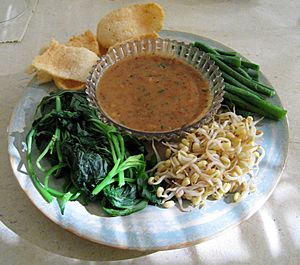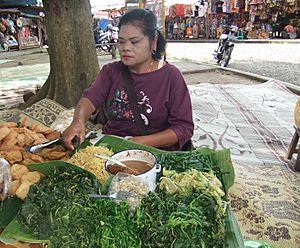Pecel facts for kids
 |
|
| Alternative names | Pecal |
|---|---|
| Place of origin | Indonesia |
| Region or state | Yogyakarta, Central Java, East Java |
| Serving temperature | Room temperature |
| Main ingredients | Vegetables in peanut sauce |
Pecel is a yummy traditional Javanese salad. It comes with a special peanut sauce. People usually eat it with steamed rice, lontong (rice cakes wrapped in banana leaves), or ketupat (rice cakes in woven palm leaves).
Pecel is easy to make and not expensive. This is why it's super popular all over Java! It's known as a quick and simple meal, often found when traveling by train across Java.
This dish also traveled to other countries. Javanese immigrants brought Pecel to Malaysia, where it's called pecal. It's also very popular in Suriname, introduced by the Javanese Surinamese people.
Contents
The Story of Pecel
How Pecel Got Its Name
Long ago, around the 1600s, there was a book called Babad Tanah Jawi. In this book, a wise person named Ki Gede Pemanahan offered a dish to his guest, Sunan Kalijaga. He called it "pecel-ized boiled vegetables."
The word "pecel" used to mean "to squeeze water out of something" in the Javanese language.
Pecel's Journey to Fame
Sunan Kalijaga was from a different part of Central Java. So, he didn't know about this dish, which was common in Yogyakarta. But soon after, Pecel became one of the most loved Javanese dishes across Java. That's when the word pecel started meaning "a side dish made of vegetables and sauce."
Pecel is one of many Javanese salads made with vegetables. It's a bit like lothek. The main difference is that lothek often has fried batter or tofu. It also uses both raw and cooked vegetables, while pecel usually uses cooked ones.
What's in Pecel?
Main Ingredients
Pecel usually has leafy greens, bean sprouts, long beans, and cabbages. Sometimes, other vegetables are added too. These can include amaranth leaves, kangkung (water spinach), or cassava leaves. People often use whatever local plants are in season. Some newer recipes might even add sliced carrots or use red cabbage for a brighter color!
The Special Sauce
The sauce is the most important part! It's made from roasted or fried peanuts. Other ingredients include asam jawa (tamarind), coconut sugar, and different spices. The sauce can be thick or thin, sweet or spicy. It all depends on where you are in Indonesia!
How to Enjoy Pecel
Pecel is usually eaten with rice or rice cakes like lontong or kupat. You can also eat it by itself. Many people like to add fried side dishes, such as fried tempeh (fermented soybean cake) or tofu. Crispy Javanese crackers like krupuk or rempeyek are also popular additions.
Different Kinds of Pecel

Pecel can taste different depending on where you try it! The main changes are in how thick the sauce is and if it's spicy, sweet, or savory.
Regional Flavors
- In Central Java, pecel sauce is usually sweet and savory, with a medium thickness. But near the northern coast, it tends to be spicier and a bit thinner.
- In East Java, especially in Madiun, the peanut sauce is very thin and quite spicy. Sometimes, lamtoro seeds (from a type of tree) are sprinkled on top.
- In Tegal, Central Java, the pecel sauce is made from peanuts and cassava root.
- In Surakarta, there's a special pecel called pecel ndeso. It uses a black sesame sauce on top of the peanut sauce.
Pecel with a Twist
- In Yogyakarta, pecel is often served with bacem (sweet-simmered) tempeh or tofu.
- In Surakarta, there's a pecel type called lothek (or lotek). This version includes some raw vegetables, lontong, and gorengan (fried snacks). The name "lothek" comes from "luthik", which is a wooden spoon used to scoop the peanut sauce from a grinding bowl.
See also
 In Spanish: Pecel para niños
In Spanish: Pecel para niños


